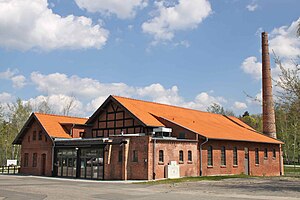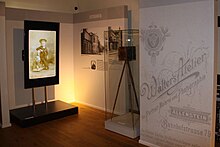Center Techniki i Rozwoju Regionu "Muzeum Nowoczesności" w Olsztynie
 Center for Technology and Development - Museum der Moderne in Allenstein |
|
| Data | |
|---|---|
| place | Olsztyn ( German Allenstein ) |
| opening | 15th October 2014 |
| Website | |
The Centrum Techniki i Rozwoju Regionu "Muzeum Nowoczesności" w Olsztynie ( German Center for Technology and Development - "Museum of Modernity" in Allenstein ) is a museum and an educational institution in which, supported by the Culture Department of the City of Olsztyn ( German Allenstein ), the technical development in the city as well as in Warmia and Mazury in the 19th century and in the first half of the 20th century is described.
history
The museum is located in the timber-framed sawmill built by Louis and Rudolf Raphaelsohn in 1884 near the Allenstein city park. With its tall chimney , it is the only remaining relic of the old industrial area of Olsztyn from the period of dynamic development of the city in the second half of the 19th and early 20th centuries. There were other sawmills, a gas works , a machine factory , breweries and a vinegar and mustard factory. Once was on the side of the building for all a pool of water, which served for collecting the floating wood.
In 1930 the buildings were taken over by the municipal utilities. Changes to the building made after the Second World War to adapt it to new functions, such as warehouses, workshops and social rooms, blurred the original function. In 1987 the plant was abandoned and left to decay. In 2010 the building was handed over to the city culture center and in 2011 the renovation work began on the building for the regional center of technology and development, which has been a listed building since 2007. Relics of the building's industrial past were uncovered in the interior and the chimney, which came from the abandoned brick factory in Rozogi, was rebuilt. The project has been through the European Regional Development Fund under the Regional Program for the Warmia and Mazury for the 2007 to 2013 co-financed .
Collections and exhibitions
The original city maps give an overview of the various technical projects in the East Prussian city from the time long before the First World War to 1945. The development of the city's transport routes with trams , omnibuses and trolleybuses from 1907 and 1939 is richly illustrated with photos the railcars of Waggon- und Maschinenfabrik AG Bautzen and Büssing -buses are described and supplemented by the tram timetable from 1913, original tickets and the model of the first tram car reconstructed from photos and descriptions.
Further topics presented in detail are the development of the city's gas, water and wastewater supply and the expansion of the electricity supply. Images show the economic development in the region beyond the city, such as the history and products of the automobile manufacturer Komnick and the machine, ship and locomotive construction company Schichau in Elbing . One chapter is devoted to the entire brewing industry in East Prussia, numerous original bottles are presented as exhibits. In addition, the “Allenstein 1910 Industrial Exhibition” is presented in all its details.
The elevator cabin from the Olsztyn town hall, built in 1912/1913, is an original showpiece on the first floor of the museum. There, the postal service in East Prussia is explained in detail with genuine documents, the development of the railways, telephone and telegraph connections. The emergence of the scheduled air traffic with the airfield Deuten and the military airship port Diwitten , the 1925 planned expansion of the Oberland Canal between Osterrode and Allenstein and the press of the region are explained.
The then emerging family photography has left a collection of portraits from the late 19th and early 20th centuries, as well as photographs of business and private rooms from the same period in 3D technology.
Large panels are dedicated to inventors and researchers in East Prussia. The life's works of Wilhelm Wien , who received the Nobel Prize for Physics for this in 1911 , and Emil von Behring , the winner of the first Nobel Prize for Physiology or Medicine , are explained in detail by the architect Erich Mendelsohn and by Johann Hermann Ganswindt , the inventor and rocket pioneer.
Special exhibitions
An entire room with numerous pictures is dedicated to the special exhibition on the current state of the Masurian Canal , which opened on April 15, 2015 .
Web links
- Manfred E. Fritsche: Modernity beyond the metropolises. Many world changes also began in Allenstein in East Prussia, as the Museum der Moderne there shows. In: kulturportal-west-ost.eu. (Issue 1358).
Individual evidence
- ^ Tartak Raphaelsohnów. Olsztyn. 24, accessed June 3, 2015 (Polish).
- ↑ Zabytki nieruchome woj.warm-maz– pow. bartoszycki. A-4482 of November 5, 2007 and January 25, 2013. In: Rejestr zabytków nieruchomych. Narodowy Instytut Dziedzictwa, p. 132 , accessed June 3, 2015 (Polish).
- ↑ Rewitalizacja Tartaku Raphaelsohnów na Centrum Techniki i Rozwoju Regionu Muzeum Nowoczesności w Olsztynie. (PDF) Retrieved June 3, 2015 (Polish).
- ↑ Centrum Techniki i Rozwoju Regionu MUZEUM NOWOCZESNOŚCI Miejskiego Ośrodka Kultury w Olsztynie - zwiedzanie od 15.10.2014 r. In: formwell.pl. Retrieved June 3, 2015 (Polish).
- ↑ CENTRUM TECHNIKI I ROZWOJU REGIONU “MUZEUM NOWOCZESNOŚCI”. Portal turystyczny Miasta Olsztyna, accessed June 7, 2015 (Polish).
- ↑ Centrum Techniki i Rozwoju Regionu "Muzeum Nowoczesności" w Olsztynie. April 22, 2014, accessed August 20, 2017 (Polish).
Coordinates: 53 ° 46 ′ 24.5 " N , 20 ° 28 ′ 52.2" E
